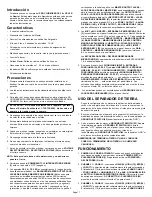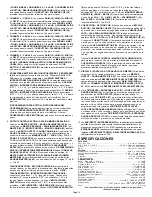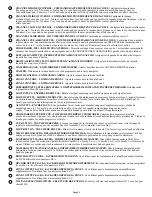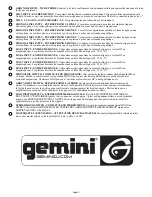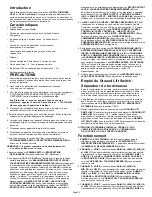
Page 8
6. CHANNEL 5: The
GAIN (22)
,
HIGH (23)
,
MID (24)
,
and
LOW (25)
controls allow you to fully adjust the selected source. Switch #
(21)
allows you to select the
MIC 3
or the
LINE 5, 6, 7, 8 or AUX INPUT
.
The
CHANNEL SLIDE or
KNOB (26)
controls the input level of this
channel. The illuminated
CUE BUTTON
(27)
allows you to cue the
channel.
7. CROSSFADER SECTION: The
CROSSFADER (28)
allows the mixing of
one source into another. The
CS-19
and
CS-19R
feature an assignable
crossfader. The
ASSIGN SWITCHES (29, 30)
allow you to select
which channel will play through each side of the crossfader. The
ASSIGN SWITCH (29)
has 6 settings (OFF, 1, 2, 3, 4 or 5) and allows
you to select channel 1, 2, 3, 4 or 5 to play through the left side of the
crossfader.
The
ASSIGN SWITCH (30)
has 6 settings (OFF, 1, 2, 3, 4
or 5) and allows you to select channel 1, 2, 3, 4 or 5 to play through
the right side of the crossfader. With the
ASSIGN
SWITCH
in the OFF
position, that side of the crossfader will be inactive.
The
CROSSFADER CURVE BUTTON (40)
allows you to adjust the kind
of curve the crossfader has. Depress the
CROSSFADER CURVE
BUTTON (40)
to make the curve steep and cutting (perfect for
scratching). Release the
CROSSFADER
CURVE
BUTTON (40)
to
make the curve gradual and gentle.
8. OUTPUT CONTROL SECTION: The level of the
MASTER OUTPUT (44,
45)
is controlled by the
MASTER BALANCE (31)
and the
MASTER
(32)
. The
BOOTH CONTROL
(33)
adjusts the level of the
BOOTH
OUTPUT (46).
HINT: The
BOOTH OUTPUT
is used by some DJs to
run monitor speakers in their DJ booth.
The
ZONE 1 (34)
and
ZONE 2
(35)
CONTROLS
are used to control the level to another ZONE or
AMPLIFIER. This balanced line uses a standard tip-sleeve connection.
(Tip= hot or positive (+), ring= cold or negative (-), and sleeve=
shield/ground.) The illuminated
LOOP BUTTON (42)
will light when the
loop is activated. The
STEREO/MONO SWITCH
(65)
assigns
ALL
OUTPUTS (44, 45, 46, 47, 48, 49)
as a mono signal or stereo signal.
The
MASTER LEVEL ATTENUATION (66)
allows you to preset the
output level of the
MASTER OUTPUTS
(44, 45)
with a choice of 3
settings (0, -6dB and -12dB).
9. TALKOVER SECTION: The purpose of the talkover section is to allow
the program playing to be muted so that the mic can be heard above
the music. The
MIC/TALKOVER SWITCH (9)
controls MIC 1 and MIC 2
and has three settings. When the
MIC/TALKOVER SWITCH (9)
is in
the “OFF” position, MIC 1 and MIC 2 and talkover are off. When the
MIC/TALKOVER SWITCH (9)
is in the “MIC 1 & 2” position MIC 1 and
MIC 2 are on, the
MIC INDICATOR (8)
will glow, but talkover is off.
When the
MIC/TALKOVER SWITCH (9)
is in the “TALKOVER” position,
MIC 1 and MIC 2 and talkover will be on and the volume of all sources
except the MIC 1 & 2 inputs are lowered by 16 dB. The
TREBLE (4)
and
BASS (5)
CONTROLS
allow you to fully adjust the tone of MIC 1 and
MIC 2.
MIC 1 LEVEL (6)
and
MIC 2 LEVEL (6)
control the individual
levels of MIC 1 and MIC 2.
10. CUE SECTION: Pressing the
MIC CUE BUTTON (7)
allows you to send
your MIC output to your cue mix. By connecting a set of headphones
to the
HEADPHONE JACK (13)
, you can monitor any or all of the
channels. A unique feature of the
CS-19
and
CS-19R
is the
CUE
BUTTON (41)
. When you press the
CUE BUTTON (41)
you will send
your cue mix (the same mix you hear in your headphones) to the booth
monitors. Press the
CUE ASSIGN BUTTONS (20, 27)
for channels 1 -
5 to select the channel or channels to be monitored and the buttons will
illuminate. The channels selected will be included in your cue mix and
can be monitored through your booth monitor speakers and/or
headphones.
Use the
CUE LEVEL CONTROL (10)
to adjust the cue volume without
affecting the overall mix. By rotating the
CUE PGM PAN CONTROL
(12)
to the left you will be able to monitor the assigned cue signal.
Rotating to the right will monitor the PGM (program) output.
11. DISPLAYS: The
PEAK HOLD LED METER (11)
indicates the
MASTER
OUTPUT (44, 45)
left and right channel levels. The individual channels
each have their own
PREFADER INPUT LEVEL LED METERS (36)
which reflect the
GAIN
,
HIGH
,
MID
,
and
LOW
rotary control
adjustments. The
CHANNEL CONTROLS (19, 26, 33, 40, 47)
will not
affect the
PREFADER INPUT LEVEL LED METERS (36)
.
12.There are
LOOP INPUTS (37)
and
LOOP OUTPUTS (38)
. If you are
using an outboard signal processor, you can use the
LOOP OUTPUTS
(38)
to send the signal to the device and the
LOOP INPUTS (37)
to
bring the signal back in to the mixer. The unit comes with jumpers to be
used with the loop inputs and outputs. Keep the jumpers in the unit if
you are not using the loop to prevent interruptions in your music
program. There are also 1/4” balanced (tip= send, ring= return, sleeve=
ground)
LOOP INPUT/OUTPUT JACKS (64)
on the rear panel, which
are connected in series with the
LOOP INPUTS/OUTPUTS (37, 38)
on
the front panel so you can add additional effects or signal processors.
13. AUX INPUTS:
The
AUX INPUTS (39)
on the front of the mixer allow
easy access for connecting an additional device such as a tape deck,
CD player, etc. EQ, Gain and Level of the
AUX INPUTS (39)
can be
controlled by assigning them to a channel by setting the
INPUT
SELECT SWITCH
(18, 21)
on any channel to the “AUX” position.
Specifications
INPUTS:
Phono........................................................................4.5mV
47Kohm Mic 1, 2, 3........................2.5mV, 2Kohm, Balanced
Line...........................................................150 mV 27Kohm
Aux............................................................150 mV 27Kohm
OUTPUTS:
Master/Zone 1, 2 (balanced/unbalanced).......0 dB 2V, 400ohm
Booth(unbalanced)......................................0dB, 1V, 400ohm
Max..............................20V Peak to Peak
Rec..............................................................150mV 5Kohm
Infrasonic Filter.........................................15Hz, 18dB/octave
GENERAL:
Bass(Mic1,2)............................................................± 12dB
Treble (Mic 1, 2)........................................................± 12dB
Gain (Mic 1, 2, 3).................................................0 to -40dB
Low (Channels 1-5)........................................+ 12dB/- 32 dB
Mid (Channels 1-5)........................................+ 12dB/- 32 dB
High (Channels 1-5).......................................+ 12dB/- 32 dB
Gain (Channels 1-5)..............................................0 to -30dB
Master Output Attenuation .........................0dB, -6dB, -12dB
Frequency Response...........................20Hz - 20KHz +/- 2dB
Distortion....................................................less than 0.02%
S/N Ratio....................................................better than 80dB
Talkover Attenuation.....................................................16dB
Power Source...................................115/230V 50/60Hz 20W
Dimensions........................................19”w x 10.5”h x 4.75”d
Weight..................................................................11.28 lbs

















